A walk around Silver Spring reveals the need to make streets and sidewalks easier to navigate for people with mobility challenges
What if you had to experience a mobility challenge? Maybe you suddenly become injured and must use crutches or a cane or perhaps you have a life-long mobility challenge where rolling is the only option instead of walking. If that happens, you may start to notice that those sidewalks and crossings you took for granted are not so accessible. Places you could comfortably travel to are now a challenge or even impossible to reach.
You might be familiar with the Standards for Accessible Design, made enforceable by the Americans with Disabilities Act (ADA), that are required for all new construction of state and local public facilities. These standards set minimum widths for public sidewalks and walkways, establish maximum slopes for curb ramps at street corners and require minimum crossing times for pedestrians at signalized intersections. Montgomery Planning, Montgomery County Department of Transportation and the Maryland Department of Transportation all take these design standards seriously and apply them to both new construction and retrofit projects. However, some experts say that the ADA design standards don’t go far enough.
Universal design, on the other hand, ensures products and environments are usable by all people, to the greatest extent possible, without the need for adaptation or specialized design. The intent of universal design is to simplify life for everyone by making products, communications and the built environment more usable by as many people as possible at little or no extra cost. Universal design benefits people of all ages and abilities[1]. It goes beyond the basic design requirements of the ADA, which frankly only requires minimal accommodation.
Montgomery Planning staff is ready to push for more universal design practices and standards in the county – but how do we build consensus among the agencies that implement roads, sidewalks and trails? As a first step, a group of planners, urban designers and engineers from the Montgomery County Planning Department, Montgomery County Department of Transportation (MCDOT) and Maryland Department of Transportation State Highway Administration (MDOT SHA) came together in April 2019 to take part in a walk audit around Silver Spring and assess existing conditions for pedestrians, especially those with mobility challenges.
What made this activity special is that it was co-facilitated by Juliette Rizzo, an enthusiastic (and thankfully patient) advocate for universal design, who understands the issues personally as she relies on a motorized wheelchair to get around. Juliette helped us gain on-the-ground experience with how someone with a mobility challenge navigates an area many of us walk around almost daily without a second thought.
Multiple times on the walk she explained that while many of the sidewalks in the county are “up to code” and meet the standards, but for some people those standards still aren’t enough to walk confidently and comfortably. In other words, she showed us how much progress we still need to make to create a built environment in line with universal design principles.
During the walk audit, the group learned several lessons, with the most significant being:
- Current push-button installments in Silver Spring are not universally accessible.
- Sidewalk pavers can become obstacles to people using mobility devices when they are uneven.
- Preserving spacious pedestrian pathways during the construction phase of a project is critical to ensuring safety.
- Busy, uncontrolled intersections are uncomfortable and unsafe for everyone, especially those with disabilities.
Lesson 1: ADA Design Guidelines Don’t Meet All Needs
Very early on in our walk audit, we approached an intersection with a push-button used to call for a pedestrian walk phase from the traffic signal. At first glance, the button seemed fine. It met the height, placement and other accessibility design requirements required by ADA; however, as soon as Juliette went to push the button, it became clear that this device was not in fact universally accessible. The footplate of Juliette’s motorized wheelchair was hitting the pedestal of the pushbutton pole, making it impossible for her to reach it.
A few days later, when participants were discussing this experience, one of them recalled a push-button signal design they encountered in Rockville and shared it with the group. This design might be easier for Juliette to use because it has an arm that extends beyond the pedestal. In this situation, a more accessible facility treatment already exists, and this model could be specified for both new projects and retrofits.
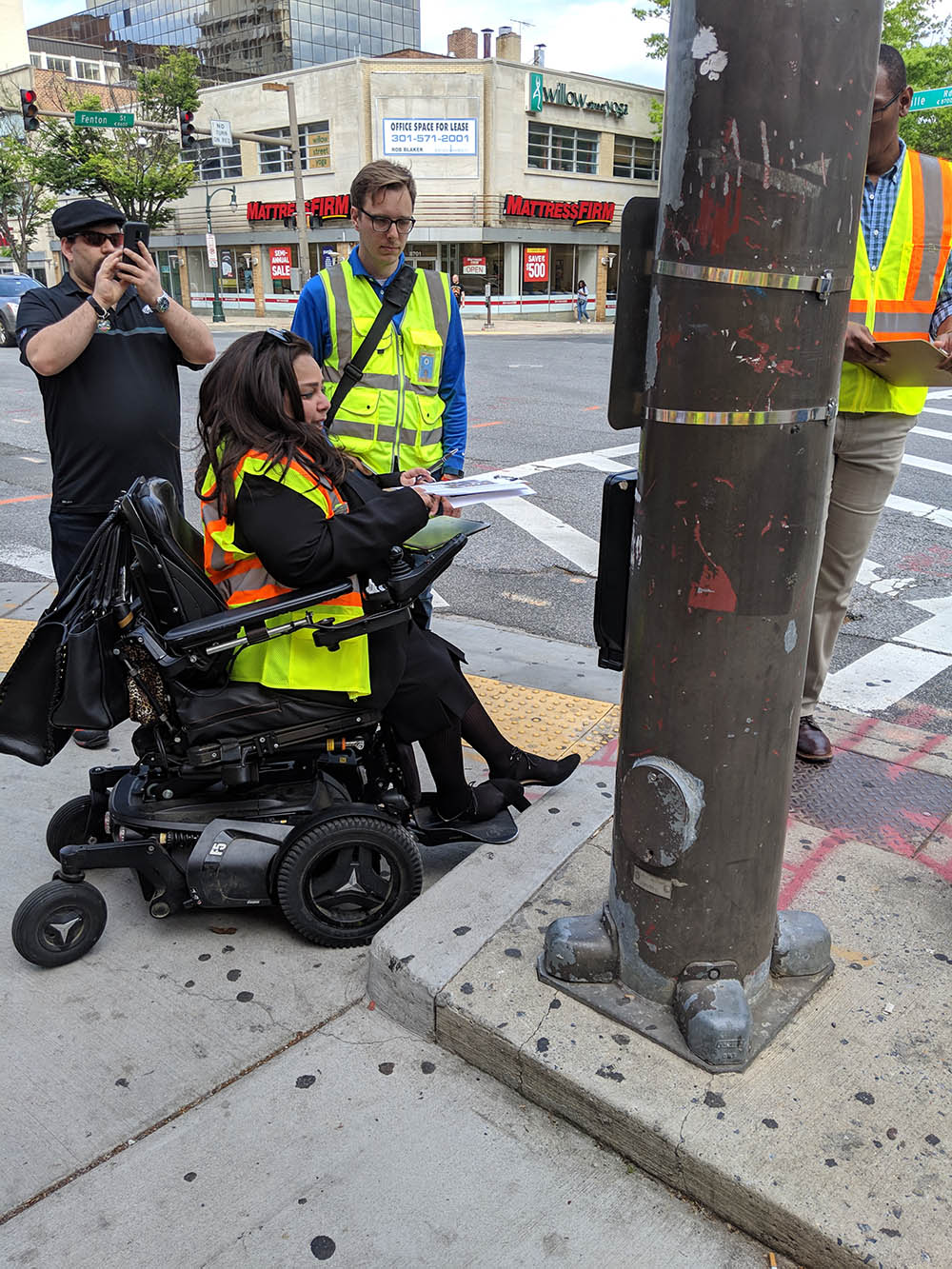
Juliette Rizzo shows planners and engineers how she is unable to reach the push button because of the way the platform was designed.
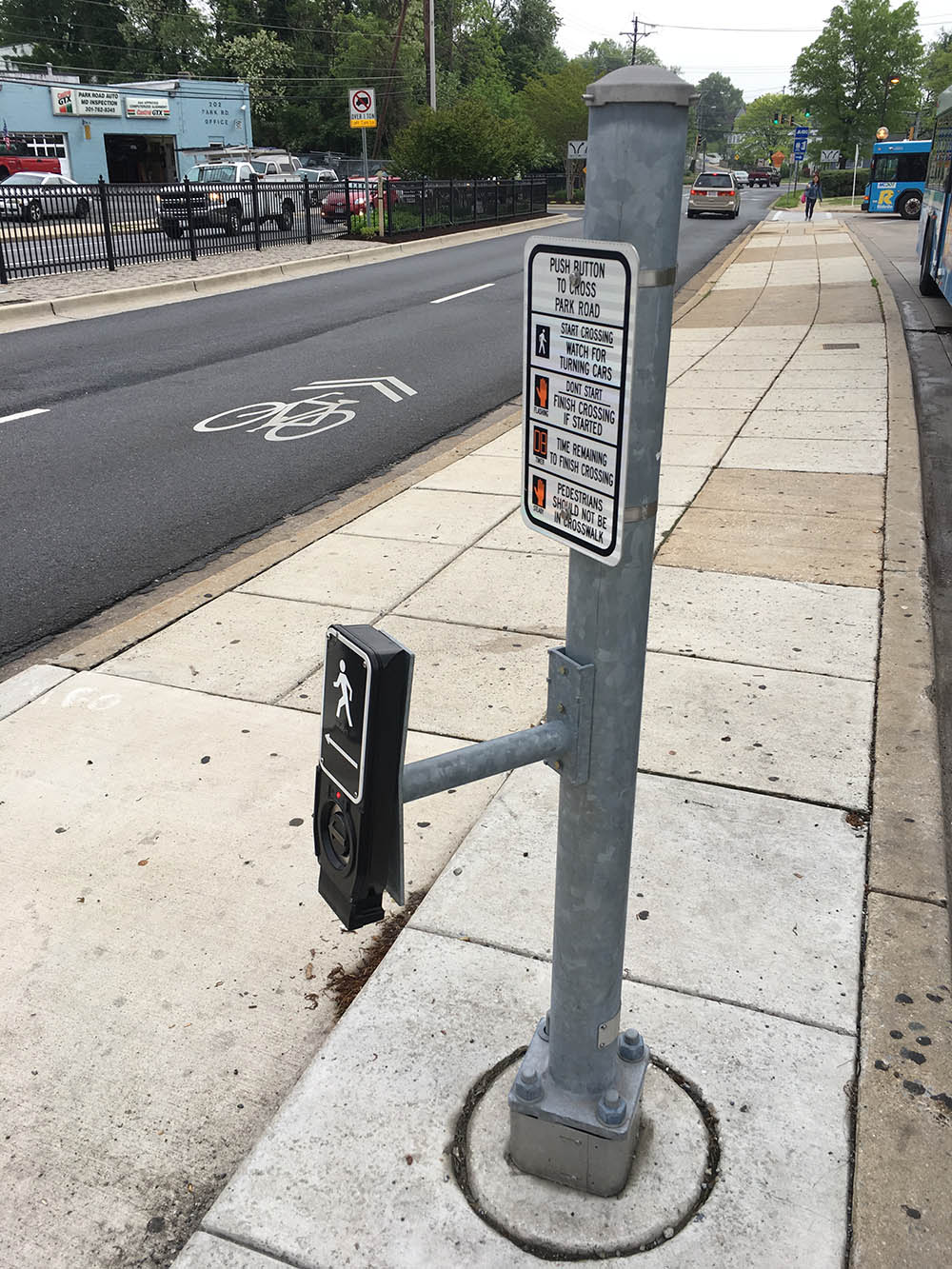
Example of a push-button pedestrian signal in Rockville, MD.
Lesson 2: Streetscapes Can Be Both Beautiful and Accessible
Silver Spring is known for its brick sidewalks laid in an intricate herringbone pattern. While charming in appearance, they become trip hazards and even unnavigable when the pavement buckles and becomes uneven over time. Juliette explained we often take our walking surfaces for granted, focusing on the person we’re talking to or the destination ahead. If a person with a disability does this and unexpectedly hits an uneven paver, the outcome can result in an injury or worse. When some people have to focus attentively on the surface they’re walking on, and not the conversation they’re having with a friend, we have not achieved universal design.
The brick paver look can be achieved without making it more difficult for everyone to travel through Silver Spring and other places with pavers. Stamped concrete can resemble the look of bricks and pavers while performing like concrete slabs that are less likely to become uneven and create tripping hazards. It may also be necessary to abandon the paver look altogether and instead keep bricks to a decorative border instead of covering the entire walking surface, so that everyone can have an enjoyable and safe walking experience. In Silver Spring, Bethesda and many other places with pavers and bricks in Montgomery County, the treatment is not historic, but purely aesthetic. We should not let a person’s a historic sense of beauty or appropriateness trump another’s fundamental freedom of movement.
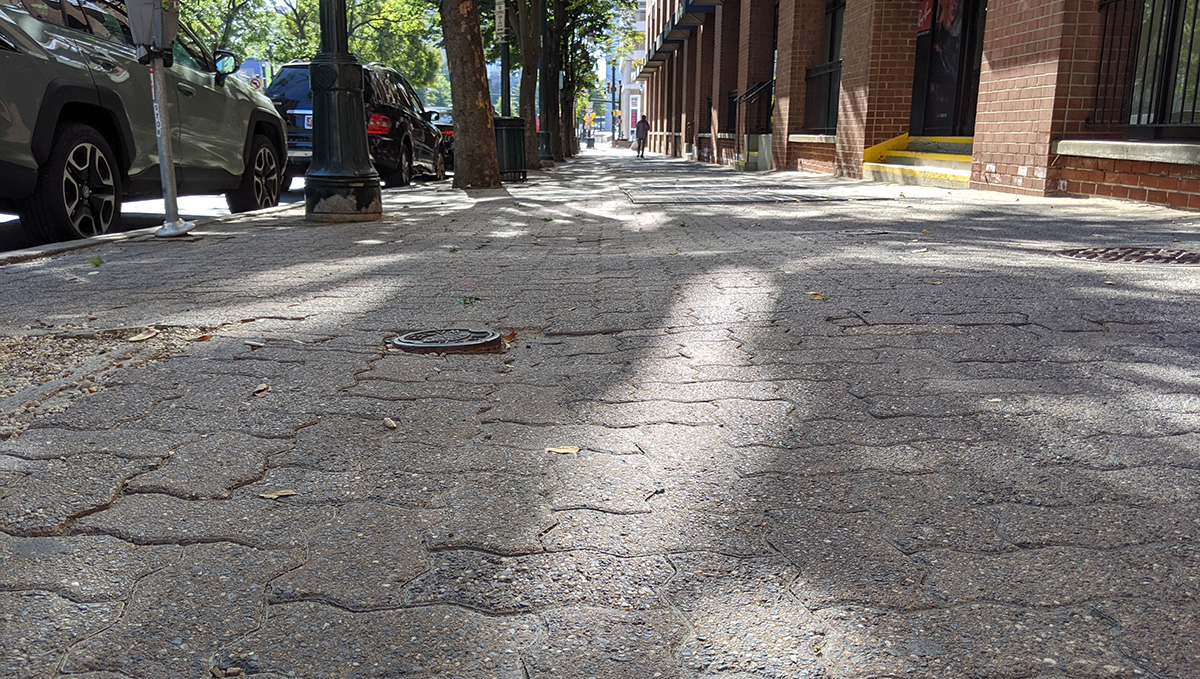
Many people take their walking surface for granted, but for someone with a mobility challenge, uneven surfaces making walking difficult, uncomfortable and unsafe.
Lesson 3: Access Needs to be Preserved at All Times
We had the opportunity to experience a sidewalk fronting an active construction site during our walk audit. It was encouraging to see the pedestrian pathway preserved and protected by a scaffold canopy rather than closed altogether, but the canopy’s supportive framing drastically narrowed the pedestrian clear pathway. Someone like Juliette would need to pass through the scaffolding single-file. Passing someone, especially someone using a walking assistance device like a wheeled walker would be impossible, so if two people using wheelchairs or pushing strollers entered at opposite ends, one would have to back up to allow the other to exit before continuing their own journey.
With some of the pavers out of joint under the scaffolding, the pathway for a person with a disability was even tighter. Juliette noted that when approaching narrow, covered walkways adjacent to construction sites, she sometimes chooses to travel in the street instead of risking getting stuck under the scaffolding where it may be too tight to turn around or avoid bad patches in the brick sidewalk. When providing cover, these temporary structures need to be wide enough for people to comfortably pass one another and turn around. Otherwise, they won’t be used and may encourage people to take unnecessary risks traveling in the road even against with traffic.
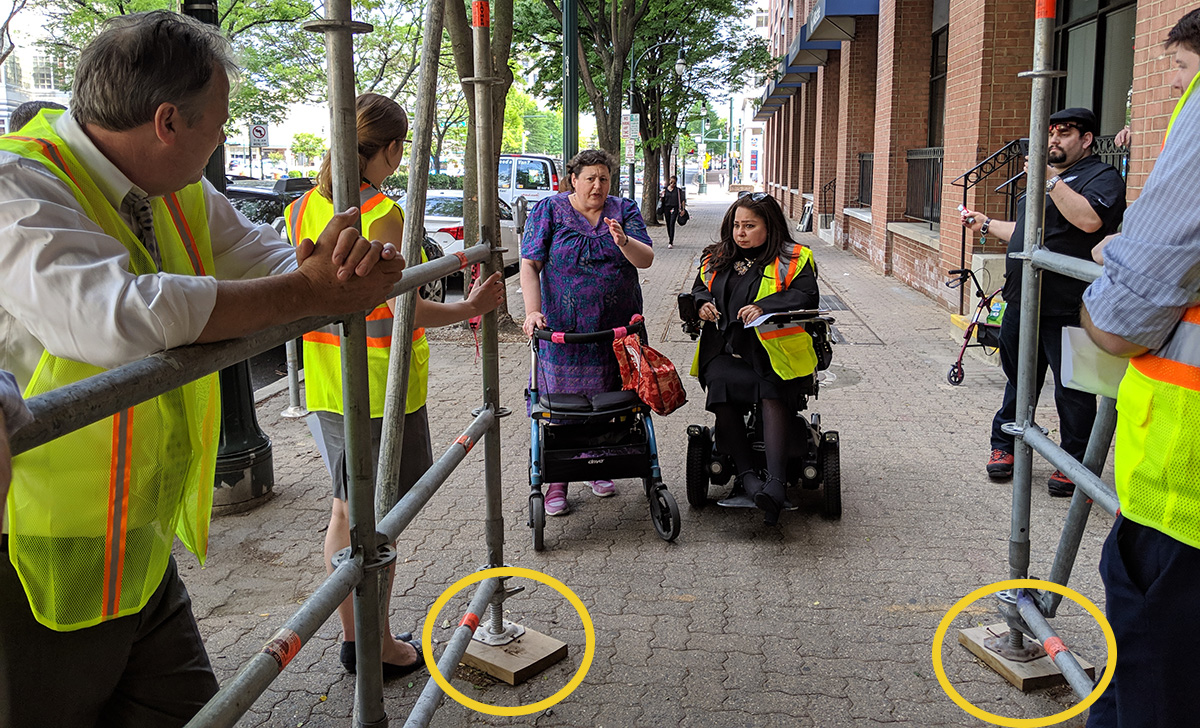
The scaffolding protecting the walkway barely accommodates two people using walking assistance devices. In fact, the circled supports narrow the walkway even further.
Lesson 4: Controlled, Comfortable Crossings are Needed for Everyone
Finally, the last crossing along the route was an uncontrolled (meaning no stop sign or traffic signal present) T-intersection at Georgia Avenue and Fenwick Lane. The crossing has some good pedestrian safety features, such as a high-visibility crosswalk, highly reflective signs pointing to the crosswalk and a pedestrian median waiting area (refuge) between opposing directions of traffic. But the design still poses safety and mobility issues.
Georgia Avenue is classified as a major highway and in this segment carries about 35,000 cars a day on average through the intersection on six lanes of traffic. With office buildings, a coffee shop and medical offices on either side of the road, pedestrians are often stuck waiting on both sides to cross.
The real issue at this crossing is communication between the pedestrians and the motorists. Drivers will sometimes stop for pedestrians in one lane, but all motorists in all lanes need to comply for the pedestrians to cross the road safely. When one car stops and the pedestrian enters the crosswalk but then a motorist in another lane fails to stop, the pedestrian is in serious danger. Without a traffic control device such as a signal, a beacon or even a stop sign, clear, predictable behavior from everyone is unlikely. Trying to negotiate this intersection in a wheelchair is even more difficult because the person crossing is shorter and less visible to cars. Someone with a visibility impairment has a difficult time knowing if all lanes of traffic have or will stop when crossing at the intersection.
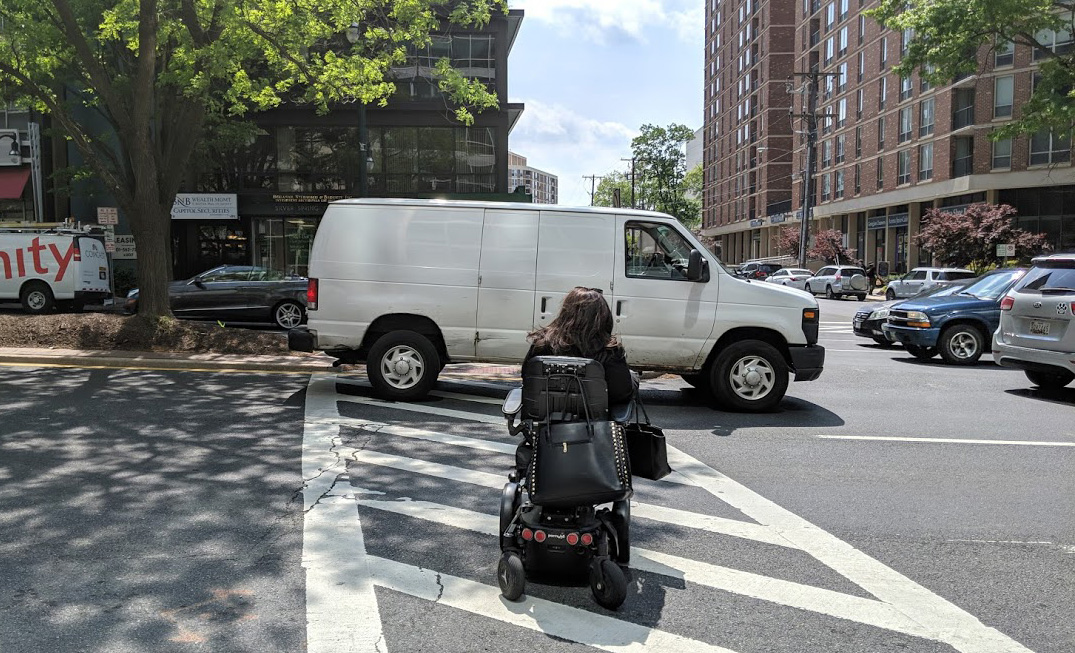
Cars sometimes queue in the crosswalk, blocking access to the median refuge.
Universal Design is Paramount to Overcoming Mobility Challenges
Since the walk audit, the group has been discussing which walking and crossing facilities are most accessible in their design and should be explicitly required when transportation projects are under review. As with the example of the push-button pedestrian signal, two different pedestrian signal installations might meet ADA accessibility standards, but one design still might be more inclusive than the other.
Furthermore, there may be effective universal design solutions used in other countries that aren’t yet officially approved by the Federal Transportation Administration. Montgomery County transportation planners are reviewing such designs and determining how and where they could be applied in the county.
We also understand that our walk audit only focused on one mobility challenge. People with visual, auditory or other impairments may have other concerns and issues with the infrastructure we experienced that were not discussed. As a multi-agency group, we are hoping to schedule more walk audits that focus on other mobility challenges throughout the county to both reinforce team building and determine how people of all ages and abilities navigate our streets and sidewalks.
Montgomery Planning believes that walking should be the most convenient, safest and most direct choice for short trips for everyone. That’s why we’re creating the county’s first Pedestrian Master Plan to provide Montgomery County government with the best practices, priorities and tools to make our communities walkable and accessible for all. Learn more about this plan at www.montgomeryplanning.org/walkinghere.
If we continue to accept ADA design standards as the best we can do, we are not providing safe walkways and crossings for everyone. Planners, engineers and urban designers at every level of government need to do more and push for universal design so people of all abilities can walk within Montgomery County safely and comfortably.
[1] The Center for Universal Design – About UD. (2019). Projects.ncsu.edu. Retrieved 18 September 2019, from https://projects.ncsu.edu/ncsu/design/cud/about_ud/about_ud.htm
A Bethesda Pedestrian
It saddens me that at this point in time, these basic lessons have to be taught to officials in our county. Look at the Netherlands for pedestrian-focused development, including during construction. Look at Bethesda for the worst of worst–narrow sidewalks, many obstructions, little or no accommodations for pedestrians, fewer and fewer shade trees (a traffic-calming device), and a complete disregard of the community’s needs. The county officials blame the state; the state says we’re busy with Silver Spring or Poolesville or Boyds or Clarksburg or Baltimore. And Bethesda pays and pays.
Mary K McQueen
I understand we can always do better as this article so clearly points out. That said a friend recently visited from Brazil remarked how wonderful it was to see people with walkers and wheelchairs out and about independently. There are very few accommodations for people with disabilities in her country and she rarely sees handicapped people in public. We have come a long way and we can always strive to do better. Thanks for pointing us in the right direction!
Laurie Kelly
An increasing number of people suffer from knee pain made worse by walking on pavement as the surface causes the knee to act as a shock absorber. The pain is often eased by walking alongside the sidewalk on a grassy or dirt surface. I request that grassy areas be provided or maintained alongside sidewalks. And, we need a natural surface alternative to paved trails in parks.
Remember, not all disabled people are using wheelchairs. Few assistive devices help walkers with knee pain.
S Barman
Don’t forget about thresholds into public buildings. My first wife, who was in a wheelchair before she died, had problems getting through thresholds that were not flush to the ground. Even a slight ridge causes problems for wheelchairs.